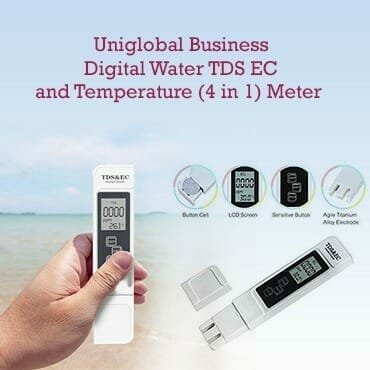
Even though they provide similar results and are well connected, there are certain differences between Electrical Conductivity (EC) meter and Total Dissolved Solids (TDS) meter. Those similarities often cause confusion, which is why we are going to explain these meters in more detail here.
What is EC Meter?

EC meter measures Electrical Conductivity. In other words, it shows how well certain materials can carry electricity. By determining the level of EC, we can also see how polluted water is. The high level of EC means that water has a high concentration of dissolved substances; therefore, it is not pure.
 However, that is not always the case as water can have a High Concentration of Dissolved Salt, which is not bad for human health. It just makes water undrinkable. EC is mostly measured in micro Siemens (µS/cm). While usual readings will have EC of between 30 µS/cm to 2000 µS/cm, seawater will have a reading of almost 50,000 µS/cm.
However, that is not always the case as water can have a High Concentration of Dissolved Salt, which is not bad for human health. It just makes water undrinkable. EC is mostly measured in micro Siemens (µS/cm). While usual readings will have EC of between 30 µS/cm to 2000 µS/cm, seawater will have a reading of almost 50,000 µS/cm.
It is very popular in gardening, where it measures the electrical conductivity of nutrient solutions, enabling you to adjust the levels of nutrients, salts, and other elements so you can have a healthier plant growth


What is TDS Meter?
Total Dissolved Solids (TDS) represent the number of dissolved substances in the liquid that are measured by the TDS meter. These substances can be organic such as minerals, salts, and calcium and inorganic such as contaminated ones.
Therefore, TDS meter measures everything that can be found in the analyzed water and is not a suspended solid. Determination of TDS is usually conducted by detecting the concentration of ions in water (EC) first. When the EC level is determined, analysts run a conversion factor to determine TDS levels. TDS is mostly measured in parts per million (ppm) but also in mg/L. Water with good quality has a TDS value between 0 and 600 ppm, while unsatisfactory TDS levels are over 1200 ppm.
The Difference Between TDS and EC meter
Even though you can use EC results to determine TDS levels, these meters are different, which is why the conversion doesn’t provide exact TDS results. TDS meter measures both particles that generate EC and those that don’t carry electricity.
Thus, EC to TDS conversion factors vary, depending on the contents that are included in the sample. These factors generally have a range from 0.4 – 1.0. That said, the substances that doesn’t impact the levels of EC, yet they do affect TDS levels, make EC measurement insufficient to determine the TDS values.
EC is usually measured and converted to TDS to provide the approximate TDS values. Furthermore, TDS meters automatically convert EC value which is determined by the conversion factor. To get the real TDS value, you need to take your sample to the laboratory where it will be further examined. You might think that it is better to use a meter that has the widest measurement range. However, using one meer that focuses on a specific area, increase the accuracy of your results.
